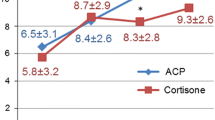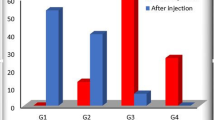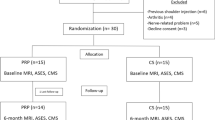Abstract
Objective
Rotator cuff tears are one of the most common causes of chronic shoulder pain and disability. They significantly affect the quality of life. Reduced pain and improved function are the goals of conventional therapy, which includes relative rest, pain therapy, physical therapy, corticosteroid injections and surgical intervention. Tendons have a relative avascular nature; hence, their regenerative potential is limited. There is some clinical evidence that the application of autologous platelets may help to revascularize the area of injury in rotator cuff pathologies.
Patients and methods
This prospective randomized controlled study was done to evaluate the results of subacromial injection of platelet-rich plasma (PRP) versus corticosteroid injection therapy in 40 patients with symptomatic partial rotator cuff tears. All patients were assessed before injection, 6 weeks, 3 and 6 months after injection, using the American Shoulder and Elbow Surgeons Standardized Shoulder Assessment Form (ASES), the Constant–Murley Score (CMS), the Simple Shoulder Test (SST) and a Visual Analog Scale (VAS) for pain. An MRI was performed before and 6 months after the injection for all the included patients and was graded on 0–5 scale.
Results
Both injection groups showed statistically significantly better clinical outcomes over time compared with those before injection. There was a statistically significant difference between RPP group and corticosteroid group 12 weeks after injection, regarding VAS, ASES, CMS and SST in favor of the RPP group. MRI showed an overall slight nonsignificant improvement in grades of tendinopathy/tear in both groups, however, without statistically significant differences between the two groups.
Conclusion
PRP injections showed earlier better results as compared to corticosteroid injections, although statistically significant better results after 6 months could not be found. Therefore, subacromial RPP injection could be considered as a good alternative to corticosteroid injection, especially in patients with a contraindication to corticosteroid administration.
Level of evidence
II.



Similar content being viewed by others
References
Chakravarty K, Webley M (1993) Shoulder joint movement and its relationship to disability in the elderly. J Rheumatol 20(8):1359–1361
Kim HM, Dahiya N, Teefey SA et al (2010) Location and initiation of degenerative rotator cuff tears. J Bone Joint Surg (Am) 92(5):1088–1096
Ho JO, Sawadkar P, Mudera V (2014) A review on the use of cell therapy in the treatment of tendon disease and injuries. J Tissue Eng 18(5):204–213
Anitua E, Andía I, Sanchez M et al (2005) Autologous preparations rich in growth factors promote proliferation and induce VEGF and HGF production by human tendon cells in culture. J Orthop Res 23:281–286
De Vos RJ, Weir A, Van Schie HT et al (2010) Platelet-rich plasma injection for chronic Achilles tendinopathy: a randomized controlled trial. JAMA 303(2):144–149
Peerbooms JC, Sluimer J, Bruijn DJ, Gosens T (2010) Positive effect of an autologous platelet concentrate in lateral epicondylitis in a double-blind randomized controlled trial: platelet-rich plasma versus corticosteroid injection with a 1-year follow-up. Am J Sports Med 38(2):255–262
Randelli P, Arrigoni P, Ragone V, Aliprandi A, Cabitza P (2011) Platelet rich plasma in arthroscopic rotator cuff repair: a prospective RCT study, 2-year follow-up. J Shoulder Elbow Surg 20:518–528
Richards RR, An KN, Bigliani LU et al (1994) A standardized method for the assessment of shoulder function. J Shoulder Elbow Surg 3(6):347–352
Constant CR, Murley AG (1987) A clinical method of functional assessment of the shoulder. Clin Orthop Relat Res 214:160–164
Lippitt SB, Harryman DT, Matsen FA, Fu FH, Hawkins RJ (1993) A practical tool for evaluating function: the simple shoulder test. In: Matsen F (ed) The shoulder: a balance of mobility and stability, American Academy of Orthopaedic Surgeons, pp 501–18
Lewis JS (2010) Rotator cuff tendinopathy: a model for the continuum of pathology and related management. Br J Sports Med 44(13):918–923
Scarpone M, Rabago D, Snell E et al (2013) Effectiveness of platelet-rich plasma injection for rotator cuff tendinopathy: a prospective open-label study. Glob Adv Health Med 2(2):26–31
Molini L, Mariacher S, Bianchi S (2012) US guided corticosteroid injection into the subacromial-subdeltoid bursa: technique and approach. J Ultrasound 15(1):61–68
Zheng XQ, Li K, Wei YD, Tie HT, Yi XY, Huang W (2014) Nonsteroidal anti-inflammatory drugs versus corticosteroid for treatment of shoulder pain: a systematic review and meta-analysis. Arch Phys Med Rehabil 95(10):1824–1831
Haraldsson BT, Langberg H, Aagaard P, Zuurmond AM, Van El B, Degroot J et al (2006) Corticosteroids reduce the tensile strength of isolated collagen fascicles. Am J Sports Med 34(12):1992–1997
Hansen M, Boesen A, Holm L, Flyvbjerg A, Langberg H, Kjaer M (2013) Local administration of insulin-like growth factor-I (IGF-I) stimulates tendon collagen synthesis in humans. Scand J Med Sci Sports 23(5):614–619
Kaux JF, Janssen L, Drion P et al (2014) Vascular Endothelial Growth Factor-111 (VEGF-111) and tendon healing: preliminary results in a rat model of tendon injury. Muscles Ligaments Tendons J 4(1):24–28
Rutgers M, Saris DB, Dhert WJ, Creemers LB (2010) Cytokine profile of autologous conditioned serum for treatment of osteoarthritis, in vitro effects on cartilage metabolism and intra-articular levels after injection. Arthritis Res Ther 12(3):213–222
Cervellin M, De Girolamo L, Bait C, Denti M, Volpi P (2012) Autologous platelet-rich plasma gel to reduce donor-site morbidity after patellar tendon graft harvesting for anterior cruciate ligament reconstruction: a randomized, controlled clinical study. Knee Surg Sports Traumatol Arthrosc 20(1):114–120
Bosch G, Moleman M, Barneveld A, van Weeren PR, van Schie HT (2011) The effect of platelet-rich plasma on the neovascularization of surgically created equine superficial digital flexor tendon lesions. Scand J Med Sci Sports 21(4):554–561
Heisterbach PE, Todorov A, Fluckiger R, Evans CH, Majewski M (2012) Effect of BMP-12, TGF-beta1 and autologous conditioned serum on growth factor expression in Achilles tendon healing. Knee Surg Sports Traumatol Arthrosc 20(10):1907–1914
Nguyen RT, Borg-Stein J, McInnis K (2011) Applications of platelet-rich plasma in musculoskeletal and sports medicine: an evidence-based approach. PM R 3(3):226–250
Cook JL, Purdam CR (2009) Is tendon pathology a continuum? A pathology model to explain the clinical presentation of load induced tendinopathy. Br J Sports Med 43(6):409–416
Rha DW, Park GY, Kim YK, Kim MT, Lee SC (2013) Comparison of the therapeutic effects of ultrasound-guided platelet-rich plasma injection and dry needling in rotator cuff disease: a randomized controlled trial. Clin Rehabil 27(2):113–122
Barber FA, Hrnack SA, Snyder SJ, Hapa O (2011) Rotator cuff repair healing influenced by platelet-rich plasma construct augmentation. Arthroscopy 27(8):1029–1035
Gumina S, Campagna V, Ferrazza G et al (2012) Use of platelet leukocyte membrane in arthroscopic repair of large rotator cuff tears: a prospective randomized study. J Bone Joint Surg Am 94(15):1345–1352
Randelli PS, Arrigoni P, Cabitza P, Volpi P, Maffulli N (2008) Autologous platelet rich plasma for arthroscopic rotator cuff repair. A pilot study. Disabil Rehabil 30(20–22):1584–1589
Jo CH, Shin JS, Lee YG et al (2013) Platelet-rich plasma for arthroscopic repair of large to massive rotator cuff tears: a randomized, single-blind, parallel-group trial. Am J Sports Med 41:2240–2248
Kesikburun S, Tan AK, Yilmaz B, Yasar E, Yazicioglu K (2013) Platelet-rich plasma injections in the treatment of chronic rotator cuff tendinopathy: a randomized controlled trial with 1-year follow-up. Am J Sports Med 41(11):2609–2616
Antuna S, Barco R, Martinez Diez JM, Sanchez Marquez JM (2013) Platelet-rich fibrin in arthroscopic repair of massive rotator cuff tears: a prospective randomized pilot clinical trial. Acta Orthop Belg 79(1):25–30
Castricini R, Longo UG, De BM et al (2011) Platelet-rich plasma augmentation for arthroscopic rotator cuff repair: a randomized controlled trial. Am J Sports Med 39(2):258–265
Weber SC, Kauffman JI, Parise C, Weber SJ, Katz SD (2013) Platelet-rich fibrin matrix in the management of arthroscopic repair of the rotator cuff: a prospective, randomized, double blinded study. Am J Sports Med 41(2):263–270
Chahal J, Van Thiel GS, Mall N et al (2012) The role of platelet rich plasma in arthroscopic rotator cuff repair: a systematic review with quantitative synthesis. Arthroscopy 28(11):1718–1727
Malavolta EA, Gracitelli ME, Ferreira Neto AA, Assuncao JH, Bordalo-Rodrigues M, De Camargo OP (2014) Platelet-rich plasma in rotator cuff repair: a prospective randomized study. Am J Sports Med 42(10):2446–2454
Zhang Q, Ge H, Zhou J, Cheng B (2013) Are platelet-rich products necessary during the arthroscopic repair of full-thickness rotator cuff tears: a meta-analysis. Am J Sports Med 22(4):213–221
Rodeo SA, Delos D, Williams RJ, Adler RS, Pearle A, Warren RF (2012) The effect of platelet-rich fibrin matrix on rotator cuff tendon healing: a prospective, randomized clinical study. Am J Sports Med 40(6):1234–1241
Jo CH, Kim JE, Yoon KS et al (2011) Does platelet-rich plasma accelerate recovery after rotator cuff repair? A prospective cohort study. Am J Sports Med 39(10):2082–2090
Ruiz-Moneo P, Molano-Munoz J, Prieto E, Algorta J (2013) Plasma rich in growth factors in arthroscopic rotator cuff repair: a randomized, double-blind, controlled clinical trial. Arthroscopy 29(1):2–9
Bergeson AG, Tashjian RZ, Greis PE, Crim J, Stoddard GJ, Burks RT (2012) Effects of platelet-rich fibrin matrix on repair integrity of at-risk rotator cuff tears. Am J Sports Med 40(2):286–293
Charousset C, Zaoui A, Bellaiche L, Piterman M (2014) Does autologous leukocyte-platelet-rich plasma improve tendon healing in arthroscopic repair of large or massive rotator cuff tears? Arthroscopy 30(4):428–435
Author information
Authors and Affiliations
Corresponding author
Ethics declarations
Conflict of interest
The authors declare that there are no conflicts of interests for this study. No funds have been received for this study by any of the authors. It was performed at University Public Hospital. The presenting author, Mohamed El-Sayed, declares that he has no conflict of interest. The first author, Ahmed Shams, declares that he has no conflict of interest. The third author, Osama Gamal, declares that he has no conflict of interest. The fourth author, Waled Ewes, declares that he has no conflict of interest.
Ethical approval
This study was performed in accordance with the ethical standards of the institutional and/or national research committee and with the 1964 Helsinki Declaration and its later amendments or comparable ethical standards. It was conducted after approval of the university ethical committee, and a written approval statement was collected from all the included subjects before surgery. This study was conducted at Menofiya University Hospitals and Tanta University Hospitals.
Informed consent
Informed consent was obtained from all individual participants included in the study.
Rights and permissions
About this article
Cite this article
Shams, A., El-Sayed, M., Gamal, O. et al. Subacromial injection of autologous platelet-rich plasma versus corticosteroid for the treatment of symptomatic partial rotator cuff tears. Eur J Orthop Surg Traumatol 26, 837–842 (2016). https://doi.org/10.1007/s00590-016-1826-3
Received:
Accepted:
Published:
Issue Date:
DOI: https://doi.org/10.1007/s00590-016-1826-3




